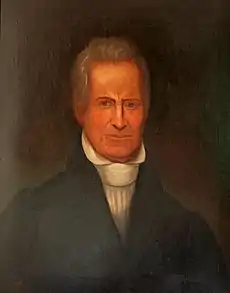Joseph Graham | |
|---|---|
 General Joseph Graham (1759-1836) | |
| Born | October 13, 1759 Berks County, Pennsylvania |
| Died | November 12, 1836 (aged 77) Mecklenburg County, North Carolina |
| Allegiance | United States of America |
| Service/ | North Carolina militia |
| Years of service | 1781-1783, 1812 |
| Rank | Major (American Revolution), Brigadier General (War of 1812) |
| Unit | North Carolina State Legion, Lincoln County Regiment |
| Commands held | North and South Carolina Militia |
| Battles/wars | Raft Swamp, Moore's Plantation, Brick House, Seven Creeks, Evacuation of Wilmington |
| Spouse(s) | Isabella Davidson Graham (1762-1808) |
Joseph Graham (October 15, 1759 – November 12, 1836) was a Revolutionary War militia officer, politician, and wealthy ironmonger from Mecklenburg County, North Carolina.[1][2]
Life story
He was born on October 13, 1759, in Chester County, Pennsylvania, to James Graham and Mary McConnell Barber Graham (2nd wife). His parents were both Scots-Irish. His father died before 1763 when he moved with his mother and siblings to Mecklenburg County, North Carolina. He became a farmer and ironmonger. In 1814 he was a Councilor of State for North Carolina. Later in life, he was on the board of trustees of the University of North Carolina.[1][3]
Military service
Joseph served as a Patriot in the American Revolution:
- Captain, NC State Legion (1781-1782)[2]
- Major, Lincoln County Regiment (1782-1783), commission on October 7, 1781, commissioned by Brig. Gen. Griffith Rutherford to serve under Col. Robert Smith. On July 25, 1782, he was under Col. Joseph Dickson (Lincoln County Regiment).
Severely wounded at the Battle of Charlotte on September 26, 1780. Graham was in many battles and skirmishes during the American Revolution including the actions at Stono, Charlotte, Cowan's Ford, Pyle's Defeat, Clapp's Mill, Raft Swamp, Moore's Plantation, Brick House, Seven Creeks and the Evacuation of Wilmington.[2][4]
During the War of 1812, he was selected as a brigadier general to lead a brigade of North Carolina and South Carolina militia.[1] As part of his service, Graham directed the construction of Fort Bainbridge located on the Federal Road in the Mississippi Territory (modern day Alabama).[5]
After the wars, he assisted Archibald D. Murphey in preparation of a book on the history of North Carolina. Although the book was never completed, his manuscripts were included in the North Carolina archives and were compiled into a book by William A. Graham in 1904.[6] This book includes a sketch of Joseph. A copy of a portrait of Joseph was made in the early 1800s.[7]
Death
He died on November 12, 1836, in Vesuvius Furnace, Lincoln County, North Carolina. He was buried at the Machpelah Presbyterian Church Cemetery in Lincolnton, Lincoln County, North Carolina.[1][8]
References
- 1 2 3 4 Williams, Max R. (1986). "Joseph Graham". NCPedia. Retrieved April 15, 2019.
- 1 2 3 Lewis, J.D. "Joseph Graham". The American Revolution in North Carolina. Retrieved April 15, 2019.
- ↑ Hunter, Cyrus L. (1877). "Sketches of Western North Carolina, Historical and Biographical". The Raleigh news steam job print. Retrieved October 21, 2014.
- ↑ https://www.cmstory.org/exhibits/mecklenburg-declaration-independence-celebration-timeline/1836-death-joseph-graham
- ↑ Waselkov, Gregory; Christopher, Raven (April 2012). Archaeological Survey of the Old Federal Road in Alabama (Technical report). Montgomery, Alabama: Alabama Department of Transportation. p. 222.
Submitted by the Center for Archaeological Studies University of South Alabama.
- ↑ Graham, William A. (1904). "General Joseph Graham and His Papers on North Carolina Revolutionary History". Retrieved April 15, 2019.
- ↑ National Society of Colonial Dames of America in Tennessee. "Portrait of General Joseph Graham". Retrieved April 15, 2019.
- ↑ Find a Grave memorial 23265920 with tombstone photo